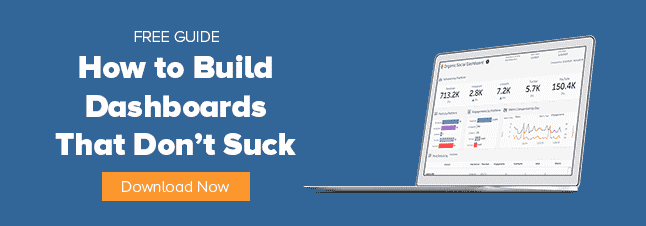
Want to be a better marketing analyst? Then there’s one skill that will absolutely make or break you: data storytelling.
Obviously, it’s important to be data literate and build a toolbox of technical skills. It’s smart to learn the ins and outs of Tableau, Power BI or whatever software you’re using.
But you’re going to see the biggest return on your time — and the biggest advances in your career — when you learn how to tell a story with data. You’ve got to be able to help your audience understand what the data is saying in a way that’s meaningful and useful to them.
And it’s not just me saying it! Gartner has highlighted consultation and communication training (storytelling, basically) as one place where marketers need to spend more time if they want to win over their stakeholders.
What Is Data Storytelling?
Data storytelling really consists of just three things. You’re using your data to explain …
- What happened with your marketing. This is Level 1 “just the facts” reporting. It may look a little different depending on your organization and the complexity of your data ecosystem, though we strongly recommend being able to view performance data at the channel and campaign level, not just by individual sources like Google Analytics or Facebook Ads.
- Why it happened. Your audience needs context. If you’ve been investing in marketing analytics for a while, you might have the tracking and attribution tools to credit the touchpoints and channels that contributed to your conversions or sales. But even if you’re using more straightforward attribution models like last click, you should have a working, data-supported theory of what’s driving your results.
- What your organization should do next. Predictive modeling is extremely helpful here, but even if you aren’t set up to use it yet, you as an analyst possess valuable expertise and should be able to make informed decisions by drawing on the data.
That’s it! Only three things! You can use a spreadsheet, a PDF or a marketing dashboard to convey that information (though, holy cow, you really should be using a dashboard) but you must answer those questions.
BLOG: Start with the Big Picture in Marketing Analytics
3 Roadblocks to Data Storytelling
So why do so many analysts struggle with data storytelling?
They’re Using Dirty, Incomplete Data
Everything has to start with clean, accurate data.
Now, there are always going to be minor discrepancies in web or media reporting. Maybe Facebook Ads says 1,500 people clicked through to your site last Friday, but Google Analytics only shows 1,490 pageviews. That’s not what I’m talking about. The real problem is when you tell your Sales team that you generated 300 conversions last month when there are only 50 in the CRM.
Automating your data collection can help prevent problems like this — it’s really easy to make errors when you’re downloading campaign data manually and then copying and pasting numbers into a spreadsheet. It’s also important to have a data strategy that clearly spells out your essential KPIs and what data sources are used to calculate them. That way, you avoid problems with undercounting or double-counting conversions. (We can help you with this.)
They’re Telling the Wrong Story to the Wrong Audience
You have to make sure that your reporting is meaningful to your audience.
Don’t show up to a meeting with your C-suite and hit them with a fire hose of irrelevant stats — big impressions here, big engagement there! If you’re talking to a senior-level audience, they won’t care because their No. 1 priority is going to be revenue. Focusing on granular, tactical questions won’t really matter to them, and your credibility will suffer.
Not that impressions and engagement are never important. A channel manager or a media buyer will be very interested in seeing those numbers. Again, it’s all about knowing your audience.
They Forget to Say What Should Happen Next
And finally, leave your audience with actionable, useful recommendations. Seriously, you won’t believe how many analysts ignore this step, when it’s arguably the most helpful thing you can do.
After all, you’ve done the hard work of gathering accurate data. You’ve painted a clear picture of what happened in a way that addresses your audience’s biggest problems and questions. By studying spend and results at a channel or campaign level, you have an idea of why things happened the way they did.
You have all the resources you need to make an expert recommendation. And I’d argue you have a duty to do that.
One of the reasons I love analytics is that it’s a blend of art and science. Getting the technical aspect is important, but don’t overlook the art of data storytelling. It’s how we translate data into a format that’s easy for our audience to understand and use. And that’s what being a marketing analyst is all about, isn’t it?
Maximize Campaign ROI with a Complete Analytics Solution
Alight’s Media Performance Analytics solution enables marketers to measure and optimize cross-channel campaigns to reduce wasted spend and improve ROI. Schedule a free solution consultation with our team!

